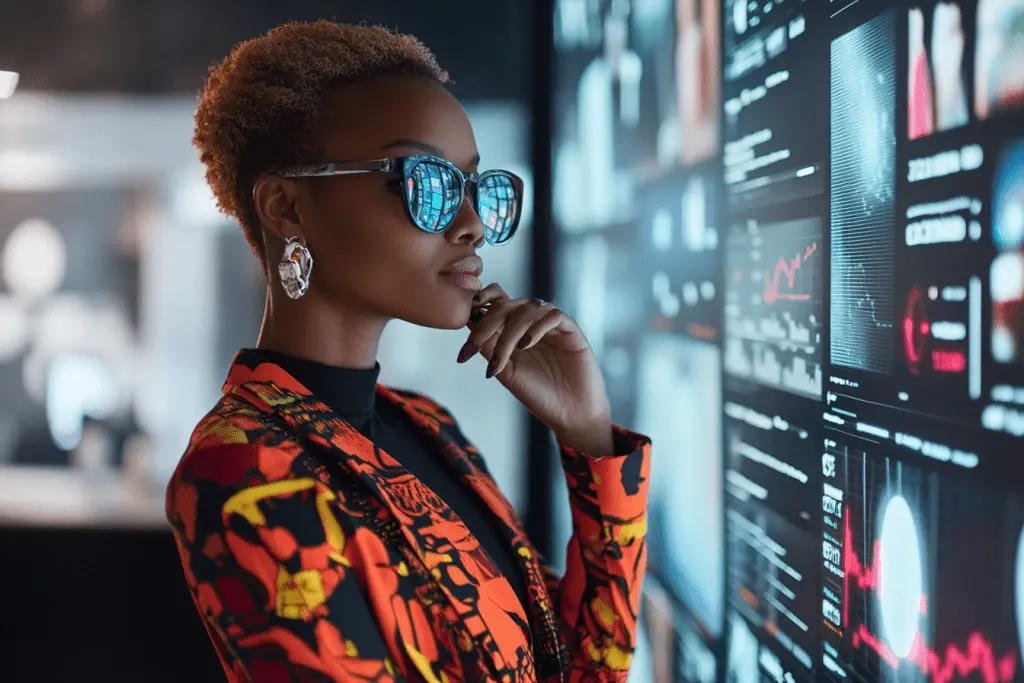Have you ever wondered how the latest fashion trends go from a designer’s sketchpad to the glittering runways of Paris, Milan, and New York? 🎨✨ The journey from concept to catwalk is a thrilling adventure, fueled by the power of fashion marketing. In today’s fast-paced, image-driven world, it’s not just about creating beautiful clothes—it’s about crafting a compelling story that captures hearts and wallets alike.
But here’s the catch: the fashion industry is more competitive than ever. With social media influencers, fast fashion giants, and luxury brands all vying for attention, how can you make your mark? 🤔 Whether you’re an aspiring designer, a budding entrepreneur, or a seasoned professional looking to up your game, mastering the art of fashion marketing is essential for success in this glamorous yet cutthroat industry.
Buckle up, fashion enthusiasts! 🚀 We’re about to embark on an exhilarating journey through the world of fashion marketing. From understanding the fundamentals to measuring your campaign’s success, we’ll cover everything you need to know to turn your fashion dreams into runway reality. Let’s dive into the ultimate guide that will transform your approach to fashion marketing, starting with the basics and building up to the grand finale of a show-stopping runway event.
From social media management to SEO and digital advertising, an effective marketing strategy can make all the difference. At International Outsourcing Group, we specialize in helping fashion brands grow their online reach, increase engagement, and drive sales through expert digital marketing. Contact us or visit our website for more information.
Understanding Fashion Marketing Fundamentals

Defining fashion marketing and its importance
Fashion marketing is the strategic process of promoting and selling fashion products, brands, and experiences to target consumers. It encompasses a wide range of activities, from market research and product development to advertising and retail strategies. The importance of fashion marketing cannot be overstated in today’s competitive industry landscape.
Fashion marketing plays a crucial role in:
- Brand awareness and recognition
- Creating desire for products
- Driving sales and revenue
- Building customer loyalty
- Staying ahead of trends and competition
In an industry that thrives on constant change and innovation, effective fashion marketing is essential for brands to stand out and succeed.
Key elements of successful fashion marketing
Successful fashion marketing relies on several key elements working together harmoniously. These elements include:
- Brand identity
- Target audience understanding
- Product positioning
- Visual storytelling
- Multi-channel marketing
- Influencer partnerships
- Customer experience
Let’s explore these elements in more detail:
Element | Description | Importance |
Brand identity | The unique personality and values of a fashion brand | Establishes recognition and emotional connection |
Target audience understanding | Detailed knowledge of customer demographics, preferences, and behaviors | Enables precise marketing strategies and product development |
Product positioning | How a brand’s offerings are perceived in relation to competitors | Differentiates the brand and justifies pricing |
Visual storytelling | Using imagery and video to convey brand narratives and product features | Creates emotional engagement and desire |
Multi-channel marketing | Utilizing various platforms (social media, print, events) to reach customers | Maximizes reach and reinforces brand message |
Influencer partnerships | Collaborating with relevant personalities to promote products | Leverages trust and expands brand reach |
Customer experience | The overall journey from discovery to purchase and beyond | Builds loyalty and encourages repeat business |
The role of branding in fashion
Branding is the cornerstone of fashion marketing. It goes beyond logos and color schemes to encompass the entire identity and perception of a fashion brand. Strong branding in fashion:
- Creates emotional connections with consumers
- Differentiates the brand from competitors
- Justifies premium pricing
- Builds customer loyalty and advocacy
- Guides marketing and product development decisions
Successful fashion brands invest heavily in developing and maintaining a consistent brand image across all touchpoints, from product design to customer service.
Analyzing target markets and consumer behavior
Understanding target markets and consumer behavior is crucial for effective fashion marketing. This involves:
- Market segmentation: Dividing the broader market into specific groups based on demographics, psychographics, and behaviors.
- Consumer research: Gathering data on preferences, purchasing habits, and lifestyle factors.
- Trend analysis: Identifying and predicting fashion trends that will resonate with target consumers.
- Competitor analysis: Understanding how competitors are positioning themselves and targeting consumers.
- Customer journey mapping: Analyzing the path to purchase and identifying key touchpoints for marketing interventions.
By thoroughly analyzing target markets and consumer behavior, fashion brands can tailor their marketing strategies, product offerings, and customer experiences to meet the specific needs and desires of their audience. This targeted approach leads to more effective marketing campaigns, improved customer satisfaction, and ultimately, increased sales and brand loyalty.
Developing a Fashion Marketing Concept

Identifying market trends and opportunities
In the fast-paced world of fashion, staying ahead of market trends is crucial for developing a successful marketing concept. To identify trends and opportunities, fashion marketers must:
- Conduct thorough market research
- Analyze consumer behavior
- Monitor social media and influencer activity
- Attend fashion events and trade shows
- Study competitor strategies
One effective way to organize and prioritize trends is by using a trend matrix:
Trend | Impact | Longevity | Relevance to Brand |
Sustainable fashion | High | Long-term | Medium |
Y2K revival | Medium | Short-term | High |
Genderless clothing | High | Long-term | Low |
Digital fashion | Medium | Long-term | High |
By analyzing these trends, marketers can identify opportunities that align with their brand’s values and target audience.
Creating a unique selling proposition
A unique selling proposition (USP) sets your fashion brand apart from competitors. To create a compelling USP:
- Identify your brand’s strengths
- Analyze competitor offerings
- Determine what makes your brand unique
- Articulate your value proposition clearly
For example, a sustainable fashion brand might have the USP: “Eco-luxe clothing that doesn’t compromise on style or the planet.”
Crafting a compelling brand story
A powerful brand story connects emotionally with your audience and gives context to your fashion marketing concept. Elements of a compelling brand story include:
- Origin: How and why the brand was founded
- Values: What the brand stands for
- Vision: The brand’s aspirations and goals
- Personality: The brand’s unique character and voice
For instance, a brand story might revolve around a designer’s journey from a small town to international runways, emphasizing perseverance and creativity.
Aligning concept with target audience
To ensure your fashion marketing concept resonates with your target audience:
- Develop detailed buyer personas
- Conduct focus groups or surveys
- Analyze customer feedback and purchasing behavior
- Tailor your messaging and visuals to audience preferences
Consider creating an audience alignment chart:
Audience Segment | Key Preferences | Marketing Approach |
Gen Z | Sustainability, inclusivity | Social media-focused, diverse representation |
Millennials | Experiential, personalization | Omnichannel, loyalty programs |
Luxury consumers | Exclusivity, quality | High-end events, influencer partnerships |
By aligning your concept with your target audience, you increase the likelihood of creating a successful fashion marketing campaign that resonates with your customers and drives brand growth.
Now that we’ve developed a solid fashion marketing concept, let’s explore how to build a comprehensive strategy to bring this concept to life.
Building a Fashion Marketing Strategy

Setting clear marketing objectives
When building a fashion marketing strategy, setting clear and measurable objectives is crucial for success. These objectives should align with your brand’s overall goals and be specific, measurable, achievable, relevant, and time-bound (SMART). Here are some key considerations:
- Brand awareness
- Sales targets
- Market share growth
- Customer engagement
- Social media followers
To illustrate, let’s look at a comparison of effective and ineffective marketing objectives:
Effective Objective | Ineffective Objective |
Increase Instagram followers by 20% in Q3 | Grow social media presence |
Achieve $500,000 in online sales by year-end | Boost sales |
Attain 85% positive sentiment in customer reviews within 6 months | Improve customer satisfaction |
Choosing effective marketing channels
Selecting the right marketing channels is essential for reaching your target audience effectively. Consider the following options:
- Social media platforms (Instagram, TikTok, Pinterest)
- Influencer partnerships
- Fashion magazines and blogs
- Email marketing
- Fashion events and runway shows
Budgeting and resource allocation
Proper budgeting and resource allocation are critical for maximizing the impact of your fashion marketing efforts. Consider the following steps:
- Assess available resources (financial, human, technological)
- Prioritize marketing activities based on potential ROI
- Allocate budget across chosen marketing channels
- Set aside contingency funds for unexpected opportunities
- Regularly review and adjust allocations based on performance
Developing a marketing timeline
Creating a well-structured marketing timeline ensures that all activities are coordinated and executed efficiently. Key elements to include:
- Seasonal collection launches
- Fashion week events
- Holiday promotions
- Influencer collaborations
- Content creation and publishing schedules
Integrating digital and traditional marketing approaches
A successful fashion marketing strategy combines both digital and traditional marketing approaches for maximum impact. Here’s how to integrate them effectively:
- Use QR codes in print ads to drive traffic to your website
- Livestream runway shows on social media platforms
- Create behind-the-scenes content for both online and offline channels
- Implement augmented reality (AR) features in-store and online
- Combine email marketing with direct mail campaigns
By seamlessly blending digital and traditional marketing tactics, you can create a cohesive brand experience across all touchpoints. This integrated approach allows you to leverage the strengths of each medium while addressing their limitations, resulting in a more comprehensive and effective fashion marketing strategy.
Now that we’ve outlined the key components of building a fashion marketing strategy, let’s explore how to design impactful fashion campaigns that will bring your strategy to life and captivate your target audience.
Designing Impactful Fashion Campaigns

Creating eye-catching visuals and content
In the world of fashion marketing, visuals are paramount. To create impactful campaigns, your visuals and content must be striking, memorable, and aligned with your brand identity. Here are some key strategies to achieve this:
- Develop a cohesive visual style:
- Choose a color palette that reflects your brand
- Maintain consistency in typography and imagery
- Create a unique visual language that sets you apart
- Embrace high-quality photography:
- Invest in professional photo shoots
- Experiment with different lighting techniques
- Showcase products in diverse settings and on various body types
- Utilize video content:
- Create behind-the-scenes footage
- Produce short, engaging fashion films
- Develop how-to videos and styling tutorials
Visual Element | Purpose | Impact |
Photography | Showcase products | Attracts attention, highlights details |
Video content | Tell brand story | Increases engagement, builds connection |
Illustrations | Add artistic flair | Sets brand apart, appeals to emotions |
Leveraging influencer partnerships
Influencer marketing has become a cornerstone of fashion campaigns. To maximize the impact of influencer partnerships:
- Choose the right influencers:
- Align with your brand values and aesthetic
- Consider micro-influencers for niche markets
- Look for authentic engagement rather than just follower count
- Develop collaborative content:
- Co-create unique pieces or limited editions
- Plan styled photoshoots featuring your products
- Encourage influencers to share their personal style tips
- Measure and optimize influencer campaigns:
- Track engagement rates and conversions
- Analyze which partnerships drive the most value
- Adjust strategies based on performance data
Utilizing social media platforms effectively
Social media is a powerful tool for fashion marketing. To make the most of these platforms:
- Tailor content to each platform:
- Instagram: Focus on visually stunning images and Stories
- TikTok: Create trendy, short-form video content
- Pinterest: Curate inspirational boards and shoppable pins
- Engage with your audience:
- Respond to comments and messages promptly
- Host Q&A sessions or live streams
- Encourage user-generated content through hashtags and contests
- Leverage platform-specific features:
- Use Instagram Shopping for easy product tagging
- Experiment with AR filters on Snapchat
- Create shoppable posts on Facebook
Implementing experiential marketing tactics
Experiential marketing creates memorable interactions between consumers and brands. In fashion, this can take many forms:
- Pop-up shops and installations:
- Create immersive brand experiences
- Offer exclusive products or personalization services
- Use technology like VR or AR to enhance the experience
- Fashion shows and events:
- Invite customers to exclusive runway shows
- Host styling workshops or masterclasses
- Organize charity events aligned with brand values
- Virtual experiences:
- Develop virtual showrooms or fitting rooms
- Create digital fashion weeks or online trunk shows
- Offer virtual styling consultations
By implementing these strategies, your fashion campaigns will not only catch the eye but also create lasting connections with your audience. Remember to continuously analyze and refine your approach based on performance metrics and audience feedback. With the right mix of visuals, influencer partnerships, social media strategies, and experiential marketing, your fashion brand can stand out in a crowded marketplace and leave a lasting impression on consumers.
A successful fashion marketing strategy requires more than just great visuals—it takes consistent social media management, high-ranking SEO, and targeted digital ads to reach the right audience. At International Outsourcing Group, we handle everything from content creation to campaign management, ensuring your brand stays visible and competitive in the ever-evolving fashion industry. Contact us or visit our website for more information.
Preparing for Fashion Shows and Runway Events

Planning and organizing a successful fashion show
Planning a successful fashion show requires meticulous attention to detail and expert coordination. To ensure your event runs smoothly, consider the following key elements:
- Venue selection
- Theme development
- Timeline creation
- Budget management
- Logistics coordination
When choosing a venue, consider factors such as capacity, ambiance, and technical capabilities. Your theme should align with your brand identity and collection concept. Create a detailed timeline that includes pre-show preparations, the event itself, and post-show activities. Manage your budget carefully, allocating resources to essential elements like lighting, sound, and décor.
Element | Importance | Considerations |
Venue | High | Capacity, ambiance, technical capabilities |
Theme | High | Brand alignment, collection concept |
Timeline | High | Pre-show, event, post-show activities |
Budget | High | Allocation for lighting, sound, décor |
Logistics | High | Transportation, setup, breakdown |
Selecting the right models and stylists
The success of your runway show heavily depends on the talent you choose to showcase your designs. When selecting models and stylists:
- Consider diversity and representation
- Look for professionals who embody your brand aesthetic
- Ensure they have runway experience
- Conduct thorough castings and interviews
Work closely with reputable modeling agencies to find the right talent. Your chosen stylists should have a strong portfolio and understand your brand vision. Remember that the right team can elevate your designs and create a memorable show experience.
Coordinating with PR and media outlets
Effective PR and media coordination is crucial for generating buzz around your fashion show. Develop a comprehensive PR strategy that includes:
- Press releases
- Media kits
- Exclusive interviews
- Influencer partnerships
Reach out to fashion journalists, bloggers, and industry insiders well in advance of your show. Provide them with compelling content and behind-the-scenes access to build anticipation. Consider hosting a pre-show event for select media representatives to give them a sneak peek of your collection.
Maximizing exposure through live streaming and social media
Extending your fashion show’s reach beyond the physical venue is essential. Leverage live streaming and social media to:
- Broadcast your show in real-time
- Create engaging behind-the-scenes content
- Encourage audience participation through hashtags
- Share highlights and key moments post-show
Choose a reliable live streaming platform and ensure high-quality video and audio production. Develop a social media content calendar leading up to, during, and after the event. Encourage attendees and models to share their experiences on social media, amplifying your show’s reach.
By focusing on these key aspects of preparing for fashion shows and runway events, you’ll be well-equipped to create a memorable and impactful experience for your audience. As we move forward, we’ll explore how to measure and optimize your fashion marketing performance to ensure continued success in the industry.
Measuring and Optimizing Fashion Marketing Performance

Establishing key performance indicators (KPIs)
To effectively measure and optimize your fashion marketing performance, it’s crucial to establish the right key performance indicators (KPIs). These metrics will help you track progress, identify areas for improvement, and make data-driven decisions. Here are some essential KPIs for fashion marketing:
- Sales metrics
- Revenue growth
- Conversion rate
- Average order value
- Brand awareness metrics
- Social media followers
- Website traffic
- Brand mentions
- Customer engagement metrics
- Email open rates
- Social media interactions
- User-generated content
KPI Category | Examples | Importance |
Sales | Revenue, Conversion rate | Directly impact bottom line |
Brand Awareness | Social media followers, Website traffic | Indicate market reach |
Customer Engagement | Email open rates, Social media interactions | Measure audience interest |
Analyzing campaign data and metrics
Once you’ve established your KPIs, it’s time to dive deep into the data. Regular analysis of your fashion marketing campaigns will provide valuable insights into what’s working and what needs improvement. Here are some key steps in the analysis process:
- Collect data from various sources (e.g., social media platforms, website analytics, sales reports)
- Use data visualization tools to identify trends and patterns
- Compare current performance against historical data and industry benchmarks
- Segment data by customer demographics, product categories, or marketing channels
- Look for correlations between different metrics to understand cause-and-effect relationships
Adjusting strategies based on results
The true power of measuring your fashion marketing performance lies in using the insights to refine your strategies. Here’s how to make data-driven adjustments:
- Identify underperforming areas and investigate root causes
- Double down on successful tactics by allocating more resources
- Experiment with new approaches based on emerging trends or competitor analysis
- Optimize your marketing mix by focusing on channels with the highest ROI
- Personalize content and offers based on customer behavior and preferences
Continuous improvement and innovation in fashion marketing
In the fast-paced world of fashion, staying ahead of the curve is essential. Here are some ways to foster continuous improvement and innovation in your fashion marketing efforts:
- Stay updated on industry trends and emerging technologies
- Encourage cross-functional collaboration between marketing, design, and sales teams
- Implement A/B testing to refine marketing messages and visual content
- Invest in marketing automation tools to streamline processes and improve efficiency
- Regularly seek customer feedback and incorporate it into your marketing strategies
By focusing on these key areas of measuring and optimizing fashion marketing performance, you’ll be well-equipped to create impactful campaigns that resonate with your target audience and drive business growth. Remember, the fashion industry is constantly evolving, so your marketing strategies should be just as dynamic and adaptable. With a data-driven approach and a commitment to continuous improvement, you’ll be able to stay ahead of the competition and create memorable fashion marketing experiences.
Conclusion

Fashion marketing is a dynamic and multifaceted field that requires a deep understanding of industry fundamentals, creative concept development, and strategic planning. From building impactful campaigns to orchestrating runway events, successful fashion marketers must navigate various challenges while staying true to their brand’s identity and vision.
To excel in fashion marketing, focus on developing comprehensive strategies that encompass all aspects of the marketing mix. Continuously measure and optimize your performance, adapting to changing consumer preferences and industry trends. By mastering these elements, you’ll be well-equipped to create compelling narratives that resonate with your target audience and elevate your brand in the competitive fashion landscape.
Whether you’re a boutique, an online store, or an established fashion brand, a well-executed marketing strategy can elevate your business to new heights. At International Outsourcing Group, we take the complexity out of fashion marketing, helping you attract more customers and grow your brand with proven digital strategies. Contact us or visit our website for more information.

